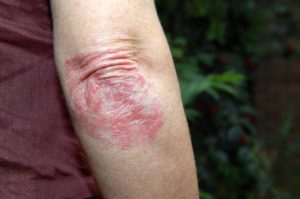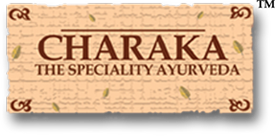 PSORIASIS is a chronic, non-contagious disorder which affects the skin and joints, characterized by flaking, redness and inflammation of the skin. Once thought to be a skin disorder, psoriasis is now understood to be a condition originating in the immune system.
PSORIASIS is a chronic, non-contagious disorder which affects the skin and joints, characterized by flaking, redness and inflammation of the skin. Once thought to be a skin disorder, psoriasis is now understood to be a condition originating in the immune system.
The scaly patches caused by psoriasis, called psoriatic plaques, are areas of inflammation and excessive skin production. Skin rapidly accumulates at these sites and takes on a silvery-white appearance. Plaques frequently occur on the skin of the elbows and knees, but can affect any area including the scalp and genitals. In contrast to eczema, psoriasis is more likely to be found on the extensor aspect of the joint.
The disorder is a chronic recurring condition which varies in severity from minor localized patches to complete body coverage. Fingernails and toenails are frequently affected (psoriatic nail dystrophy) – and can be seen as an isolated finding. Psoriasis can also cause inflammation of the joints, which is known as psoriatic arthritis. 10 to 30% of people with psoriasis have psoriatic arthritis.
Psoriasis is considered a non-curable, long-term (chronic) skin condition. It has a variable course, periodically improving and worsening. It is not unusual for psoriasis to spontaneously clear for years and stay in remission. Many people note a worsening of their symptoms in the colder winter months.
Psoriasis is seen worldwide, in all races, and both sexes. Although psoriasis can be seen in people of any age, from babies to seniors, most commonly patients are first diagnosed in their early adult years. Patients with more severe psoriasis may have social embarrassment, job stress, emotional distress, and other personal issues because of the appearance of their skin.
Psoriasis typically looks like red or pink areas of thickened, raised, and dry skin. It classically affects areas over the elbows, knees, and scalp. Essentially any body area may be involved. It tends to be more common in areas of trauma, repeat rubbing, use, or abrasions.
Psoriasis has many different appearances. It may be small flattened bumps, large thick plaques of raised skin, red patches, and pink mildly dry skin to big flakes of dry skin that flake off.
Sometimes pulling of one of these small dry white flakes of skin causes a tiny blood spot on the skin. This is medically referred to as a special diagnostic sign in psoriasis called the Auspitz sign. Genital lesions, especially on the head of the penis, are common. Psoriasis in moist areas like the navel or area between the buttocks (intergluteal folds) may look like flat red patches. These atypical appearances may be confused with other skin conditions like fungal infections, yeast infections, skin irritation, or bacterial Staph infections.
On the nails, it can look like very small pits (pinpoint depressions or white spots on the nail) or as larger yellowish-brown separations of the nail bed called “oil spots.” Nail psoriasis may be confused with and incorrectly diagnosed as a fungal nail infection.
On the scalp, it may look like severe dandruff with dry flakes and red areas of skin. It may be difficult to tell the difference between scalp psoriasis and seborrhea (dandruff). However, the treatment is often very similar for both conditions.
The real cause of Psoriasis is still unknown. However, the experts believe lots of factors behind it. Psoriasis becomes more complex when it occurs with some pre-existing diseases.
There are two main hypotheses about the process that occurs in the development of the disease. The first considers psoriasis as primarily a disorder of excessive growth and reproduction of skin cells. The problem is simply seen as a fault of the epidermis and its keratinocytes. The second hypothesis sees the disease as being an immune-mediated disorder in which the excessive reproduction of skin cells is secondary to factors produced by theimmune system. T cells, a type of white blood cell, usually protect the body against infection and disease by attacking bacteria and viruses. However, when you have psoriasis, your T cells mistakenly attack your skin cells instead. Your body then produces other immune system responses, leading to swelling and rapid production of skin cells. Psoriasis tends to run in families and it usually appears between the ages of 10 and 45.
Psoriasis is an inherited disease. However there are certain triggering factors such as injury to the skin, vaccinations and certain medications that have been responsible for the development of this condition. It usually takes about a month for new cells to move from the lower layers of the skin to the surface. In psoriasis, this process takes only a few days, resulting in a buildup of dead skin cells and formation of thick scales.
Psoriasis occurs more likely in dry skin than oily or well-moisturized skin. Excessive alcohol consumption, obesity, lack of or overexposure to sunlight, stress, cold climate, physical illness, streptococcal or HIV infection, superficial wounds, or taking certain drugs such as lithium, beta-blockers such as propranolol, anti-malarial medications and in general poor health results in flaring up of psoriasis.
The symptoms of psoriasis can manifest in a variety of forms. Different types of psoriasis exhibit different characteristics that may change over time. One form may change to another, or several forms may exist at the same time.
- Plaque psoriasis: This is the most common type of psoriasis. It is characterized by raised, red lesions covered with silvery white scales. The scales are caused by a building up of dead skin cells. It may appear on the knees, elbows, scalp, trunk or any other skin surface.
- Guttate psoriasis: It is characterised by numerous small red dots of psoriasis. The lesions may have some scaling. These numerous spots of psoriasis appear over large areas of the body, such as the trunk, limbs, and scalp. It may appear suddenly following a bacterial or viral infection or the administration of drugs like ketoconazole and salicylic acid.
- Inverse psoriasis: This is usually found in the folds of the skin in the armpits, groin, under an overweight stomach or under the breasts. It appears as smooth, red lesions without scaling and may cause irritation due to rubbing and sweating.
- Pustular psoriasis: It is characterized by blisters filled with pus on the skin. The blisters are not infectious. It may be found on the hands and feet or may be spread all over. The skin under and surrounding pustules is red and tender.
- Psoriatic arthritis: About 10% to 30% of the patients with psoriasis may develop a form of arthritis called psoriatic arthritis. This may cause redness and swelling, primarily on the hands, feet, knees, hips, elbows and spine. It may cause stiffness, pain and joint damage.
- Nail psoriasis: produces a variety of changes in the appearance of finger and toe nails. These changes include discolouring under the nail plate, pitting of the nails, lines going across the nails, thickening of the skin under the nail, and the loosening and crumbling of the nail.
- Erythrodermic psoriasis: involves the widespread inflammation and exfoliation of the skin over most of the body surface. It may be accompanied by severe itching, swelling and pain. It is often the result of an exacerbation of unstable plaque psoriasis, particularly following the abrupt withdrawal of systemic treatment. This form of psoriasis can be fatal, as the extreme inflammation and exfoliation disrupt the body’s ability to regulate temperature and for the skin to perform barrier functions.
Severe cases of psoriasis have been shown to affect health-related quality of life to an extent similar to the effects of other chronic diseases, such as depression, hypertension, congestive heart failure or type-2 diabetes. Depending on the severity and location of outbreaks, individuals may experience significant physical discomfort and some disability. Itching and pain can interfere with basic functions, such as self-care, walking, and sleep.
Plaques on hands and feet can prevent individuals from working at certain occupations, playing some sports, and caring for family members or a home. Plaques on the scalp can be particularly embarrassing, as flaky plaque in the hair can be mistaken for dandruff. Medical care can be costly and time-consuming, and can interfere with an employment or school schedule.
Individuals with psoriasis may also feel self-conscious about their appearance and have a poor self-image that stems from fear of public rejection and psychosexual concerns. Psychological distress can lead to significant depression and social isolation.
Diagnosis of psoriasis is usually based on the appearance of the skin. There are no special blood tests or diagnostic procedures for psoriasis. Sometimes a skin biopsy, or scraping, may be needed to rule out other disorders and to confirm the diagnosis.
Psoriatic Arthritis
Here, Psoriatic Arthritis requires a special mention as it may develop in up to 30 percent of people who have the chronic skin condition Psoriasis. Anyone who has psoriasis and joint pain may have psoriatic arthritis. Common symptoms of psoriatic arthritis include:
- Pain, swelling, or stiffness in one or more joints.
- Joints that are red or warm to the touch.
- Sausage-like swelling in the fingers or toes, known as Dactylitis.
- Pain in and around the feet and ankles, especially tendinitis in the Achilles tendon or Plantar fasciitis in the sole of the foot.
- Changes to the nails, such as pitting or separation from the nail bed.
- Pain in the area of the Sacrum (the lower back, above the tailbone).
Along with the above noted pain and inflammation, there is extreme exhaustion that does not go away with adequate rest. The exhaustion lasts for days to weeks without abatement. Psoriatic arthritis may remain mild, or may progress to more destructive joint disease. Periods of active disease, or flares, will typically alternate with periods of remission.
Psoriatic arthritis is a lifelong condition that causes deterioration, pain, and stiffness in the joints. Some people experience only joint problems and never develop psoriasis. About 70% of people who get psoriatic arthritis develop psoriasis first. Studies show that in these cases, psoriasis usually precedes psoriatic arthritis by about 10 years. However, a person can develop psoriatic arthritis within a few months of getting psoriasis or decades later.
Psoriatic arthritis most commonly involves the fingers and toes. Joints in the neck, back, knees, ankles, and other areas also may be affected. In addition to being painful and stiff, the involved areas usually feel hot. Affected joints tend to have a purplish discoloration.
Almost 90% of people who develop psoriatic arthritis see nail involvement first. The nails may pull away from the nail bed or develop pitting, ridges, or a yellowish-orange discoloration. Dermatologists urge their patients who have psoriasis that involves the nails to contact them if they experience any joint problems. Joint deterioration can be prevented with treatment.
Early warning signs of psoriatic arthritis include hand pain, foot pain, and “tennis elbow.” These early warning signs may be overlooked if psoriasis lesions are not present. Other indications are shoulder, neck, or back pain.
Psoriatic arthritis ranges in severity. It can involve one digit or an entire hand. It can become so severe that it is disabling. According to the National Psoriasis Foundation, about 20% of patients living with psoriatic arthritis have more than five totally damaged joints, which significantly impairs their ability to perform everyday tasks and reduces their quality of life.
Ayurveda perspective & Management of Psoriasis

Psoriasis is believed to occur due to vitiation of all the three doshas (Vata, Pitta, Kapha) in varying degree, but predominantly Vata and Kapha according to the Ayurvedic concept.
Ekakusta, kitibha and Sidma are some of the types of Kshudra and Maha Kustas (skin diseases) narrated in Ayurveda closely resemble the classical symptoms of Psoriasis.
The predominance of vatha causes pain, dryness and scaling of skin. Pitha vitiation leads to burning sensation, redness, inflammation etc and that of kapha causes rashes, itching, discharge, thickening of skin etc. From these signs and symptoms, the doshic involvement is analyzed carefully in each patient, which is of utmost importance in the management of this disease.
Irregular food habits, consumption of foodstuffs that are advised not to be eaten together (incompatible foods like dairy products with fish), excessive intake of yogurt, paneer, black gram, seafood, sour and salted items etc can activate the pathogenesis. The produced toxins accumulate in deep tissues like rasa (nutrient plasma), rakta (blood), mamsa (muscles), and laseeka (lymphatic). These toxins cause contamination of deeper tissues, leading to Psoriasis. Alcohol and tobacco consumption will act as a catalyst here. Ayurveda also emphasizes on the effect of stress in the pathogenesis of Psoriasis.
The vitiated doshas affect the skin and blood tissues. They also influence water element of the affected region on skin. Thus the skin which is influenced by affected doshas becomes discolored (white or copper colored), scaly and thin.
At CHARAKA, our treatment primarily focuses on blood purification and balancing the vitiated Doshas. Management of Psoriasis comprises of:
- Shodhana chikitsa (Detoxification) done through Panchakarma therapies like Vamana, Virechana, Rakta mokshna etc & an exclusive therapy called Thakra dhara
- Shamana chikitsa through administration of internal medication and external applications
- Rasayana chikitsa (immunomodulation) through kayakalpa
- Very strict Diet regime
- Lifestyle changes
- Stress management
We have experienced best treatment success rate in treating Psoriasis. If the patient can implement all the instructions as advised and completely follows the diet regime & healthy lifestyle, Psoriasis is completely curable without any recurrence.

